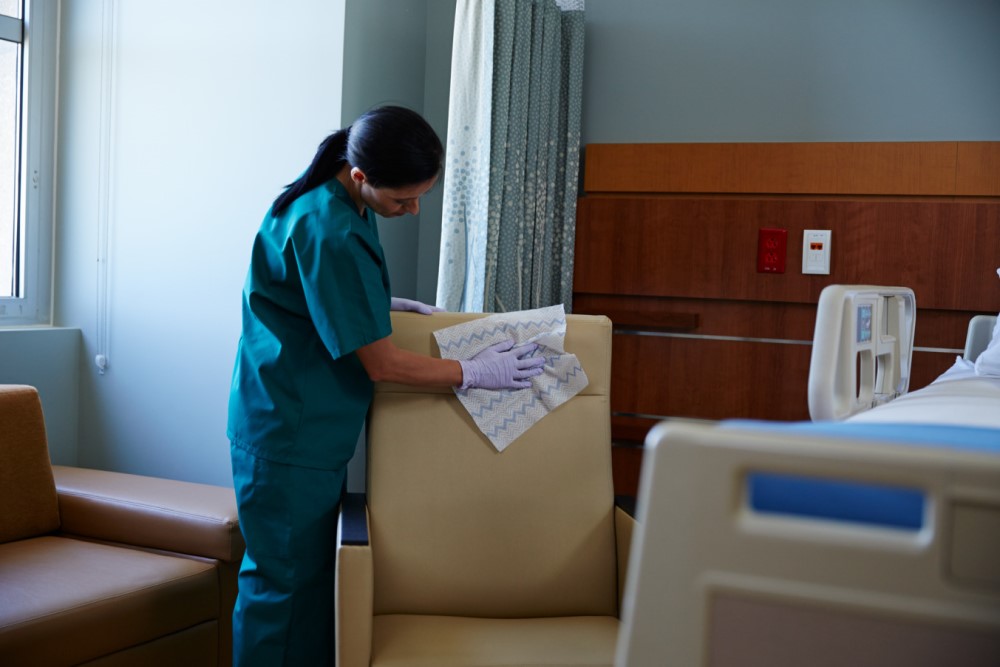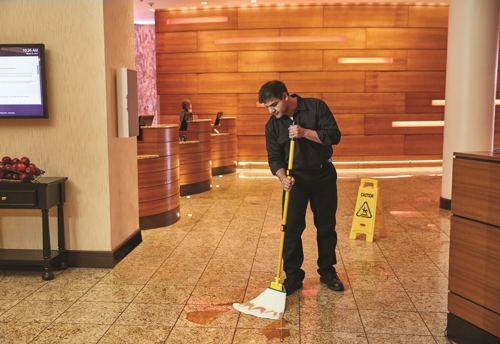
In sectors like healthcare, hospitality and education — where cleanliness directly impacts safety and operations — deep cleaning is vital. Our guide delivers practical cleaning tips and a structured checklist for effective deep cleaning across these essential industries.
Deep cleaning extends beyond general cleaning by focusing on areas prone to harbour bacteria and allergens. Our checklist provides clear, step-by-step instructions, ensuring your cleaning service teams are prepared to handle everything from daily cleaning routines to specialised tasks such as carpet cleaning, window cleaning and upholstery maintenance. This guide is designed to support environments that demand rigorous hygiene standards — such as the ones mentioned above — and helps ensure all areas meet top cleanliness criteria.
The Importance Of Deep Cleaning
Safety, professionalism, as well as space and asset longevity all depend on thorough cleaning in the following ways:
General Health And Safety
By eliminating pollutants and allergens, which might be higher indoors than outdoors, deep cleaning both stops the spread of germs and enhances air quality. Deep cleaning is supported for keeping clean surroundings by authorities such as Safe Work Australia. This guarantees a safer environment for all and helps to prevent diseases.
Professional Look
A neat area makes a favourable impression and demonstrates that a company pays attention to details. Keeping this quality up ensures clients and guests see you as a professional. This can affect their opinion of the professionalism and credibility of a business or any commercial institution.
Maintaining And Preserving Assets
Deep cleaning extends and preserves the life of commercial assets including carpets and furniture. According to the Australian Cleaning and Restoration Academy, it lessens wear and tear, which saves money by reducing the frequency of replacement or repair of these products. Employing a professional deep cleaning service can help make the most of your investment in assets and maintain them for longer.
Get Your Cleaning Arsenal Ready
First, it’s best to understand what deep cleaning actually is. There’s no easy definition, and every organisation will have a different version that targets specific needs. Essentially, you can think of deep cleaning as a spring clean for your business.
It starts with general cleaning practices like scrubbing surfaces, vacuuming and dusting — similar to what you do in domestic cleaning – but then moves to more extensive and elaborate cleaning procedures. A deep cleaning checklist will help refine these procedures and ensure they are done — and done well.
Essentially, a deep cleaning checklist is a list of cleaning tasks split up into different categories, including rooms or spaces that need to be cleaned. A daily, weekly or monthly cleaning checklist will be necessary to ensure your company’s professional cleaning services team is aware of what tasks need to be done and how often. A checklist's goal is to ensure every step is finished and nothing important gets missed.
According to Safe Work Australia, cleaning with simple detergent and water works for regular routine cleaning, but stronger disinfectant and more rigorous cleaning practices are necessary to kill all germs and reduce the risk of disease transmission. 
What Products Do Professionals Use?
It's clear that the most effective commercial cleaning outcomes are achieved when your professional cleaning service uses top-quality cleaning supplies. Now, let’s take a closer look at what these are in the following industries:
1. Hospital And Care Facility Cleaning
For patient rooms, use the 8-sided fold methodology with a damp microfibre cloth to clean ledges and window sills. Work high to low and in the same direction until all ledges and sills have been cleaned. Your cleaning company should clean furniture and furnishings with a green microfibre cloth, ensuring that every item is wiped from the upper surfaces to the lower surfaces. Spot clean the walls, bedside rails, and footboard using a damp, unused microfibre cloth. If the patient is not in the room, properly wipe down the mattress as well. Disinfect the bathroom toilet, sink and counter with a clean green microfibre cloth and wipe the mirror with a microfibre glass cleaning cloth and glass cleaner. In other hospital spaces, such as MRI rooms, follow detailed procedures to enhance safety.
2. Education Cleaning
In classrooms, use a damp microfibre cloth to sanitise individual desks, chairs, electronics, light switches, drawer handles, door knobs and bookshelves. Wet mop the floor starting at the opposite end of the door and using a “figure 8” pattern. Clean windows, vacuum the carpet and apply spot cleaner directly to any stains. Disinfect entryways, lobbies, common spaces and lounge seating areas using a spray bottle of disinfectant and a microfibre cloth.
3. Hospitality Cleaning
For hotels and lodging, use the 8-sided fold methodology with a damp microfibre cloth to disinfect the entryway, check-in desk, communal seating areas, elevator, stairwell and lobby. Carefully mop the floors in the lobby, guest rooms and suites with a microfibre flat mop. Prepare guest rooms by dusting surfaces from top to bottom with a microfibre cloth, cleaning and disinfecting the closet and mirror, making the beds, vacuuming and disinfecting the carpets and ensuring all amenities are refilled as needed. Also, disinfect the toilet, sink, shower, shower curtain and counter with disinfectant and a microfibre cloth. For more details on the differences and importance of cleaning versus sanitisation, read our detailed guide.
You can find all our Rubbermaid cleaning products and procedures on our website.
Plan The Deep Cleaning
Effective deep cleaning always starts with a well-thought-out plan, so make sure to evaluate your institution’s requirements before starting the cleaning process. First, pick the locations that need the greatest care, what kinds of surfaces need to be cleaned, and what unique problems these regions could bring. Then, decide how often deep cleaning should be done — this will depend on how often they are used and their susceptibility to filth and pollutants. Some areas may require more frequent attention than others.
Next, coordinate with your cleaning crew to match their schedules with the deep cleaning strategy. Let them know about the work's scope and the required standards. Discussing the order in which the cleaning chores should be done can also improve efficiency. For example, less used sections could be cleaned during off-peak hours to minimise interference with your business.
Decide what cleaning supplies and equipment should be used so that the crew has all they need before they begin. This could involve procuring specialised cleaning agents for different types of surfaces (such as upholstery cleaning) or securing additional equipment for high areas and hard-to-reach spots (like ceilings).
What To Expect From A Deep Clean
Your deep cleaning checklist will include company-specific sanitising needs, but you can expect to start with a few basics: dusting, washing walls and windows, scrubbing or vacuuming the floors, wiping all surfaces and sanitising used equipment or tools. To make a checklist, take inventory of what spaces need to be cleaned and list out each specific cleaning task that needs to be done in each area. This will give you a better idea of your company’s particular requirements. Once the list is complete, the cleaning staff can assemble necessary cleaning products, move all furniture that might be in the way and start cleaning.
One other important thing to note is the difference between cleaning and disinfecting. According to Food Standards Australia & New Zealand, cleaning is the removal of general dirt, grease and waste, while sanitising destroys microorganisms. To deep clean, every item or space must be cleaned before being disinfected. For example, dust or sweep the floor before mopping with strong sanitiser or soapy water.
Refine Your Cleaning Techniques
Use professional techniques for the best commercial cleaning results.
Walls
Start by dusting the walls with a microfibre cloth to remove dust and grime. After dusting, take a different microfibre cloth and gently wipe the walls in a circular motion. Make sure to avoid outlets and other sensitive areas. Wipe baseboards with a damp cloth to remove any leftover water or dust, and clean cabinets if your business has them.
Floors
After sweeping or dusting all dirt and dust with a push broom or dust mop, use a mop with a microfibre wet pad to remove virus and bacteria. For carpeted floors, first vacuum and then scrub with carpet cleaning solution.
Surfaces
According to the Australian Department of Health and Aged Care, any hard surface should be wiped down with a damp microfibre cloth from top to bottom. These surfaces include tables, doorknobs, light switches, countertops, keyboards, faucets, sinks, window sills, ceiling fans and handles.
Do A Final Sweep Of The Cleaning Checklist
Once every space is clean, the cleaning staff should review the daily cleaning checklist to confirm that each task has been thoroughly completed. To ensure the highest standards of cleanliness, explore Rubbermaid's range of professional cleaning products. Click here to find the right tools for every cleaning task.
FAQs
1. How To Deep Clean?
Start by decluttering the area to make every corner accessible. Use appropriate cleaning products for different surfaces and tackle tough stains and grime. Use high-efficiency vacuums to capture finer particles, and clean thoroughly in high-touch areas like doorknobs and light switches. Clean systematically from top to bottom and from one end of the room to the other to avoid spreading dirt around.
2. What Is Typically Included In Deep Clean?
Deep cleaning tackles areas often missed in routine cleaning, such as washing baseboards, cleaning under furniture and inside appliances like ovens and refrigerators. It also includes detailed dusting, scrubbing of bathroom grout lines, descaling faucets and sanitising fixtures. In offices, this extends to sanitising workstations and common areas.
3. How Often Should You Deep Clean?
The frequency depends on the space's usage. High-traffic areas like commercial spaces may need monthly deep cleaning, while less frequented spaces might be fine with quarterly sessions. Homes generally benefit from semi-annual deep cleaning, with kitchens and bathrooms possibly needing more frequent attention. Adjust the schedule based on the specific needs and usage of the space.